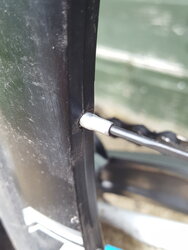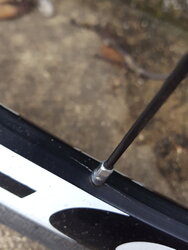The pictures suggest that there aren't any eyelets on the rim. Most/all of my wheels use eyeleted rims, but I'd be keen to know if there is any science that backs up my choice wrt rim longevity.
Most eyelets are cosmetic and only assist with building the wheel - eyelets being made from plated steel and this creates less friction when turning a nipple under tension than a nipple turning in naked aluminium would.
The cosmetic eyelets are so-called single eyelets which are crimped steel and only grip the exterior rim wall. I don't see how they distribute the spoke pulling stress over a larger surface area as claimed by some manufacturers. I would say if the wheelbuilding (some machines don't work well with nipple friction) method can tolerate not having eyelets, that's a better option.
Proper eyelets are sockets that engage both the inner and outer rim surface. The spoke in effect pulls on both layers and, the one layer has a hugely reduced surface area for the stress to distribute and dilute. Rims made with these eyelets and where the anodizing depth is kept to a minimum, last a very long time. Think Mavic MA2. Mavic's MA40 which was essentially the same rim but with deep anodizing and a single eyelet, lasted about a week.
Here's a single eyelet rim that failed. As I said, the eyelet does not increase the surface area of the stress region in the rim. It is exactly the same size as the nipple head.
Here's a non-eyeleted carbon wheel failing in the same mode. This is an Enve rim with a very stupid design where the internal suface in the nipple area is milled out. It is impossible to stress relieve these wheels and hence, impossible to guarantee long spoke life.
Here is a double-eyeleted or rather, a socketed rim. I have a better photo somewhere but can't find it now. But basically you're looking at a cut-through and can see how the socket flares out to pull on the internal cavity. Unfortunately you cannot see how it is crimped on the interior wall but at least you can see how spoke tension hangs from the exterior wall and pushes against the interior wall. You can also imagine the increased surface area.
Rims built like this have gone out of fashion for a few reasons:
1) Weight weenies have spoilt the party by demanding lighter products which are inferior. Sockets commit the crime of weighing a few grams.
2) Rim profile fashion. Sharp edges denote faster bicycles but sharp profiles don't allow engineers proper stress distribution - as seen in the OP's case.
Edit: here's the missing photo:
This eyelet is actually a two-part device. One is the large socket you can see there in gold. Look carefully and you'll see at the bottom if it, it is crimped onto the rim with a real eyelet just like in the first photo. These are erroneously called double-eyelet rims but are more accurately, socketed rims. The sockets have the added advantage of speeding up wheelbuilding since the nipple auto-positions itself in the cavity and never disappears inside the rim - the bane of the builder.


